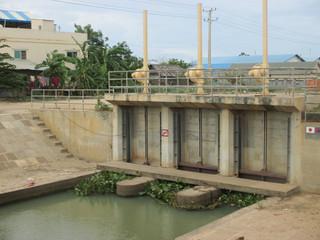This blog post is a result of the Delta workshop: “An anthropology of and for river deltas” held in August 2016 at the Department of Cultural and Social Anthropology (University of Cologne) and raises the question of the potential benefits of fusing rhythms and infrastructure to our understanding of deltas and to debates about infrastructure.
We all know that deltas are blessed with many natural advantages and provide a myriad of ecosystem services that allow for easy human settlement, dwelling and working.
We also know that deltas’ environments are not immediately favourable to human activities and that they have a long tradition of building, taming, or in other words, of infrastructuring (Van Staveren and Van Tatenhove, 2016). As illustrated in the images of irrigation systems, land uses, dams, agricultural planning and flood risk management, many deltas have been worked by humans in ways that brought them into being as agricultural spaces. Flood management infrastructures are constructed to reduce or prevent the detrimental effects of high water levels in rivers or coastal areas, water distribution systems are built to provide farmers with reliable water supply.
Deltas have accordingly been shaped by those infrastructures, which also have direct implications for the organization of social life. Both the set of activities that is required to make infrastructures work and the practices that they may enable (e.g. irrigation, cropping patterns, etc.) are indicative of the performative dimension and mutual adjustment – both in space and time – of social practices and infrastructures. Different aspects of temporalities are then configured and enacted through infrastructures. The protecting role performed by embankments, for example, is tied to the maintenance work that is applied on a daily and yearly basis to support the coherence of the whole system. Yet, infrastructures are not merely spatial and temporal, they are also rhythmic.
‘Infrastructures possess the power to shape human time, shaping the preconditions under which we experience time’s structure and its passage’ (Edwards, 2003).
The process of infrastructuring engenders diverse, emergent practices (and rhythms) that are profoundly (re)composing the various ways of being-in-the-world (Pickering, 2013). The introduction of modern rice technology, such as hybrid rice seeds and chemical fertilizers can, for instance, modify the tempo of paddy rice production, accelerating plant growth maturation and enabling additional cropping cycles. Irrigation canals, sluice gates, low-lift pumps, agricultural techniques all provide directions on how freshwater is made, orchestrating the wet and the dry. If infrastructures differentially move people, identities and social roles, I suggest that they do so following a fundamentally rhythmic pattern. The question then arises as to where to situate the rhythm in infrastructure.
The use of tubes to convey water from irrigation canals to the plot in a field located in Đức Hòa district, Province of Long An, Vietnam (Photo credit Benoit Ivars)
When considering whether infrastructures are or can generate rhythms, the larger question is whether we mean the infrastructure itself or the wider assemblage in which it is embedded. It has become generally agreed upon that infrastructures are not inert, static things and that they come into being in relation with differing socio-environmental entities and processes (e.g. river flooding, tides, erosion, rice and other crops life cycle, etc.) which can be regarded as complex rhythms (Jones, 2010). The operation of sea protection sluices which are raised to protect lands from flooding and saline water intrusion needs, for instance, to be in synch with sea level changes, tidal movements and the flow of freshwater. The rhythms that are generated by such movement of synchronization should then not be conceived as idiosyncratic, but rather as situated in between human actors and the natural, physical or material world. This raises, in turn, a number of questions such as:
- What can be defined as infrastructure in deltas? How do we identify the assemblages?
- How do we look at the various entities/processes that are influencing delta inhabitants’ ways of dwelling and their differing time scales?
- How can we theoretically and methodologically investigate the rhythms of deltas?
Conceiving deltas as polyrhythmic ensembles is one way to understand how such fragile, hybrid and intermediary environments have been performed, not solely as a result of manifold social and material relations, but of the interrelated and mutually resonating rhythms of those entities and processes. Infrastructures and infrastructure making may hence serve as a compass to better situate the times of deltas and apprehend how delta inhabitants have dealt with their ever-changing and ever-varying environment.
References
Edwards, P.N., 2003. Infrastructure and Modernity: Force, Time, and Social Organization in the History of Sociotechnical Systems, in: The History of Sociotechnical Systems. Modernity and Technology, Cambridge, MA: The MIT Press. T. J. Misa, P. Brey, & A. Feenberg (Eds.), pp. 185–226.
Jones, O., 2010. The Breath of the Moon’: The Rhythmic and Affective Time-spaces of UK Tides, in: Geographies of Rhythm: Nature, Place, Mobilities and Bodies. Oxford: Ashgate.
Pickering, A., 2013. Being in an environment: a performative perspective. Natures Sciences Sociétés 21, 77–83.
Van Staveren, M.F., Van Tatenhove, J.P.M., 2016. Hydraulic engineering in the social-ecological delta: understanding the interplay between social, ecological, and technological systems in the Dutch delta by means of delta trajectories. Ecology and Society 21.

